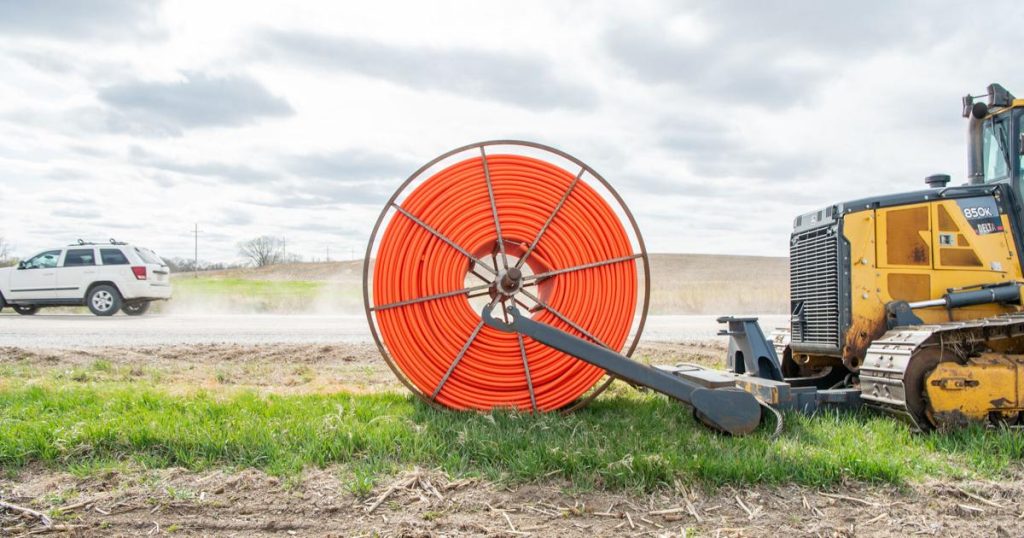A vast majority of Nebraskans said their home internet is very or mostly dependable, according to the 2023 Nebraska Annual Social Indicators Survey conducted by the University of Nebraska-Lincoln.
The study by the Bureau of Sociological Research found 45% of the 1,450 Nebraskans surveyed believe their home internet service is very dependable, while 41% reported their online connection is mostly reliable.
But where Nebraskans live plays a large role in whether they reported their internet was reliable or fast, the survey found, while other factors such as age, education level and income also show disparities.
For example, 50% of Nebraskans living in cities or towns told UNL researchers their home internet is very dependable, while only 26% of those living on a farm or in the open country felt the same way.
Those living outside of population centers were more likely to report their internet connection being just somewhat or not dependable. Twenty-eight percent of Nebraskans who live on farms and 22% of those living in open country said their connection was not reliable, the survey found.
People are also reading…
For Nebraskans living in and around Omaha, 9 out of 10 were most likely to say their internet connection was very or mostly dependable, while in Southeast Nebraska, including Lincoln, 87% of survey respondents said their internet was very or mostly dependable.
Other regions of the state — which have been a focus for Nebraska lawmakers who have appropriated funds to connect them with broadband internet — reported less-dependable internet, according to the survey.
In northern Nebraska, nearly 30% said their internet was not dependable, while 23% of respondents from the Panhandle also reported having somewhat or not dependable internet.
The UNL survey also found other sociological factors affect how dependable and fast respondents said their internet is.
Roughly 90% of Nebraskans aged 19 to 44 said their internet was both reliable and fast compared to about 80% of respondents 65 years and older.
More than half (53%) of Nebraskans in the younger age bracket said their internet was very dependable, while 42% described it as very fast. Just 36% of Nebraskans older than 65 said their internet was very dependable, and only 19% described it as fast.
Nebraskans with higher levels of education also reported having more dependable connections and faster internet speeds in the latest survey.
Of those with a bachelor’s degree, 93% said they had very dependable or mostly dependable internet, compared to 74% of those with a high school diploma.
In terms of internet speed, 93% of those with a college degree described their internet speed as very fast or somewhat fast, while 80% of respondents who did not go to college said the same.
Nebraskans with higher incomes were also more likely to describe having reliable and fast connections in their homes.
Fewer than 20% of respondents who reported incomes less than $30,000 said their internet connection was very fast compared to 41% of those with incomes greater than $100,000, for example.
The “Nebraska Snapshot” put out by UNL’s Bureau of Sociological Research last week comes as federal and state lawmakers have poured hundreds of millions of dollars into connecting unserved and underserved areas of Nebraska with high-speed internet.
Last year, Nebraska learned it would receive $405 million in federal money as part of the Broadband Equity, Access and Development program created by Congress in 2021.
That funding could help connect an estimated 50,000 households this year.
The Nebraska Public Service Commission also has made more than $150 million available to internet service providers in the form of grants to reach areas without connection speeds of 100 megabits per second.
According to Cullen Robbins, director of the Nebraska Universal Service Fund and telecommunications for the Public Service Commission, a total of $59.2 million has been allocated through the Nebraska Broadband Bridge Program.
Since its inception in 2021, the Bridge Program has connected 5,431 unserved and 11,477 underserved locations to high-speed internet throughout the state.
Another broadband infrastructure program administered by the Public Service Commission, the Capital Projects Fund, has provided $92.3 million in grants to connect 2,442 unserved and 7,520 underserved homes since it was created in 2023.
Download the new Journal Star News Mobile App
Top Journal Star photos for June 2024

Tommy Arsiaga huddles with young boxers at The Complex on Tuesday. Arsiaga and his wife Tina bought the six-acre Champions Fun Center two years ago and turned into a training center for at-risk youths in Lincoln.

Connor McFayden of Lincoln cleans up broken tents on Saturday morning at the Star City Pride Fesitval space near Pinnacle Bank Arena. Heavy rain and wind damaged vendor booths and the stage.

Julie York, a foster parent with Brave Animal Rescue, holds eight week old kittens (from left) Piglet, Pooh Bear and Roo on Friday, May 31, 2024. York has a dedicated “kitten room” built in her basement to house foster kittens for up to four to six weeks at a time. As a foster parent, York has taken care of 94 animals that have since been adopted.

Elijah Harris (from left) breaks a water balloon over the head of Joshua Williams, 12, as Alicio Brown, 9, throws a water balloon, while Amarien Bonebright, 8 escapes carrying ammunition during a Community Day event put on by Black African Family at Woods Park on Friday, June 7, 2024, in Lincoln.

Daylilies are seen in bloom in front of the state Capitol on Monday in Lincoln. Temperature in Lincoln reached a high of 87 degrees on Monday according to the National Weather Service. Tuesday is expected to reach 84 degrees with storms possible.

Minnie Anderson, 92, (left) embraces 104-year-old WWII veteran Andy Meyerle as he is welcomed back home from a D-Day honor flight on Thursday at the Savannah Pines Retirement Community. Anderson and Meyerle sit together and play card games during happy hour every day.

Lincoln’s Drew Devine (3) makes a diving catch in the second inning against Lake Country on Thursday at Haymarket Park.

Piano keys are reflected in the sunglasses of Lewade “Big Wade” Milliner, an Omaha native who is the lead singer/pianist of the band Big Wade & Black Swan Theory, as he performs with his band-mates at the Rococo Theatre during the first Jazz in June show of the year Tuesday. The show, scheduled for the Sheldon Sculpture Garden, moved inside because of the forecast.

Jaz Shelley (center) smiles during her youth basketball skills camp Thursday at Speedway Sports Complex.

Lincoln Indian Center board member John Yoakum (left) and executive director Steve Laravie Jr. load bottled water onto a truck to be delivered to the Santee Sioux Reservation on Wednesday in Lincoln.

Cedars employees Nate Wright (from left), Jay Voigt and Nicole Woebbecke share information about their organization during the Give to Lincoln Day nonprofit festival on Thursday at Tower Square. See story, Page A1.

Joseph Kruger (from left) wipes his eyes next to Deputy Lancaster County Public Defenders Sarah Safarik and Shawn Elliott as the state gives the opening statement during his trial Tuesday at Lancaster County District Court.

The South team celebrates their win after the 66th annual Shrine Bowl of Nebraska game on Saturday, June 1, 2024, at Cope Stadium. South won 17-10.

Ginnie Lewis of Lincoln (left) points to Lincoln musician Bill Chrastil (right) as he sings “These Boots Are Made for Walkin'” during the Veterans Freedom Music Festival Saturday at Antelope Park.

Lincoln Saltdogs’ Drew Devine (3) takes a moment to ready himself in the dugout before taking on the Kane County Cougars at Haymarket Park on Wednesday, May 29, 2024, in Lincoln.

Enyssa Arps (left) and Cole Kampschneider shop for herbs from the Green School Farms booth during the Hub Farmers Market on Wednesday at Union Plaza. The farmers market, which features live music, food and a number of vendors, is every Wednesday from 5-7 p.m. through Sept. 25.

Independent Senate candidate Dan Osborn (right) answers questions from audience members during a townhall at the Lincoln Labor Temple on Tuesday.
Reach the writer at 402-473-7120 or [email protected].
On Twitter @ChrisDunkerLJS
#Internet #reliability #speed #vary #Nebraska,
#Internet #reliability #speed #vary #Nebraska

